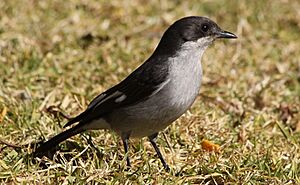Fiscal flycatcher facts for kids
Quick facts for kids Fiscal flycatcher |
|
|---|---|
 |
|
 |
|
| Male and female | |
| Conservation status | |
| Scientific classification | |
| Genus: |
Sigelus
|
| Species: |
silens
|
| Synonyms | |
|
Melaenornis silens |
|
The fiscal flycatcher (Sigelus silens) is a small bird that belongs to the Old World flycatcher family. It's a type of passerine bird, which means it's a 'perching bird' – like most songbirds you see. It's the only bird in its group called Sigelus.
These birds live and have their babies in countries like Botswana, South Africa, Lesotho, Mozambique, and Swaziland. Sometimes, they might visit Namibia for a short time, but they don't usually live there. You can find fiscal flycatchers in warm, open forests, dry grasslands (savannas), bushy areas, and even in gardens near towns.
Contents
What Does the Fiscal Flycatcher Look Like?
This black and white bird gets its name because it looks a bit like the northern fiscal and southern fiscal shrikes. These shrikes are also black and white, like someone wearing a suit and tie. That's why they were called "fiscal" – like a tax collector!
Spotting the Male Fiscal Flycatcher
The male fiscal flycatcher might be confused with the fiscal shrikes. But there are a few key differences. Shrikes have strong, hooked beaks. They also have white patches on their shoulders, not on their lower wings. Plus, shrikes have longer tails with no white on them.
Scientists think the fiscal flycatcher looks like the shrike on purpose. This is called Batesian mimicry. It means a harmless animal looks like a dangerous one to scare off predators.
Size and Colors
The fiscal flycatcher is about 17 to 20 centimeters (7 to 8 inches) long. Adult males are black on top and white underneath. They have white patches on their wings and white on the sides of their tails.
The female fiscal flycatcher is brown on top. She looks a bit like a young fiscal shrike. Young fiscal flycatchers look like females but are duller. They also have brown spots and wavy patterns on their feathers.
Sounds of the Fiscal Flycatcher
The song of this bird is a soft, chattering sound. When it senses danger, its alarm call sounds like "tssisk."
The fiscal flycatcher is bigger than the male collared flycatcher. The collared flycatcher has a white collar around its neck. It also doesn't have the white wing patches that the fiscal flycatcher has.
How Does the Fiscal Flycatcher Behave?
Fiscal flycatchers are interesting birds. They build their nests carefully and find different kinds of food.
Building a Home: Nesting Habits
The fiscal flycatcher builds a nest shaped like an open cup. It uses thin stems and other plant materials. The inside of the nest is soft, lined with plant fuzz. They usually place their nests in a thick bush or a dense part of a tree. In this way, their nesting habits are similar to the fiscal shrike.
What Do They Eat?
Fiscal flycatchers mostly eat insects. They are good at catching insects while flying. But they also eat insects that don't fly, like caterpillars.
They are clever hunters! They might eat spiny caterpillars, also known as "woolly worms." First, they rub these caterpillars on the ground or on tree bark. This helps to remove the worst of the spines.
These birds also enjoy eating small wild berries. They like berries from plants like Halleria and Chrysanthemoides. They also drink nectar from flowers that have a lot of it, like some types of Aloe. If they live near people, they might even eat scraps of food from gardens.


